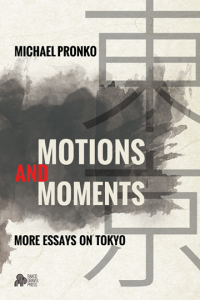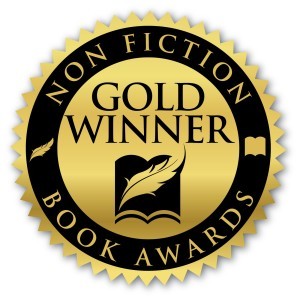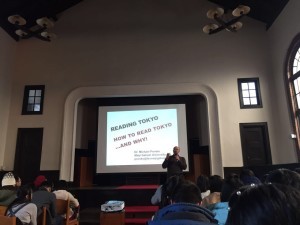Michael Pronko's Blog, page 19
February 27, 2016
The Bookbag Review
Adapting a Buddhist metaphor, Michael Pronko declares that ‘writing about [Tokyo] is like catching fish with a hollow gourd.’ In other words, it is an elusive and contradictory place that resists easy conclusions. Anyone who has seen the Bill Murray film Lost in Translation will retain the sense of a glittering, bewildering place that Westerners wander through in a daze. A long-term resident but still a perpetual outsider, Pronko is perfectly placed to notice the many odd and wonderful aspects of Tokyo life.
The essays in this book, most of them few-page vignettes, originally appeared in Newsweek Japan, and were first collected for publication in 2006. A second volume, Tokyo’s Mystery Deepens, was published in 2009. Pronko’s topics are varied and surprising. He notices the kinds of things that might be taken for granted by the Japanese and overlooked entirely by visitors, such as the prevalence of vending machines and bottle displays or the popularity of store bags, loyalty cards, and truck deliveries. He takes readers to unexplored gaps, like those between properties – where cats and rubbish collect to ‘create an atmosphere of loneliness.’
Most people think of Japan as an orderly, rule-driven society. Pronko acknowledges that Tokyo life is governed by timetables – ‘Clocks hang everywhere and few wrists go watch-less … [people] relish a kind of cleanliness of time. Open time seems sloppy and confusing’ – but also notices that the Japanese are often late or waste time. Likewise, a national obsession with maps does not equate to logical spatial arrangements: ‘Tokyo is NOT a comforting city of straight, easy-to-follow lines … Yet, on maps, the city seems to make perfect sense.’
Similarly, the Japanese are not always what they seem. It is true that they are secretive and respectful when it comes to money, and they are usually reserved in terms of physical affection. However, all that goes out the window for the month of December, when bonenkai parties dominate.
These pieces feel flowing and natural, perhaps because many arose simply from walking around, people-watching. Pronko sees a woman in head-to-toe pink and ponders how unusual the colour is in the often ‘sedate’ Japanese wardrobe. He delights that mobile phones have not totally replaced reading on trains. Indeed, the practice of tachi-yomi (reading standing up) proves that nothing will keep the Japanese from reading. In-your-face T-shirt slogans like ‘THIS AFFECTS YOU’ are another constant source of amusement.
My favourite essays were ‘Singing in the Rainy Season’ and ‘The Love of Small Places’. Despite the inconvenience, Pronko finds theatrical beauty in days of torrential rain: ‘Umbrellas turn the sidewalks into a pumping carousel of coloured half-spheres. Everyone sways like jugglers in a huge rainy parade.’ The latter essay considers miniaturisation: haiku, bonsai, and interior design. Like Alain de Botton in The Architecture of Happiness, Pronko asserts that design ‘shapes how one experiences the environment.’ Both of these pieces (and Part Five in general) testify to Pronko’s facility with visual art.
My main point of criticism is that the structure of the collection is sometimes arbitrary. Two essays that would have been helpful at the very start, ‘How I Ended Up Here’ and ‘Japan and Me,’ come later on. These give background information about Pronko growing up in Kansas City, Kansas and moving to Japan on a lark. Combined, those two essays would have made a good introduction. The piecemeal effect of magazine writing means that a few pieces feel redundant. For instance, soon after an essay on stairs, do we really need one about escalators? Also, given the subtitle, I might have expected more about Japanese cuisine.
Small quibbles aside, I recommend these poetic, whimsical essays. Pronko uses fresh metaphors, like ‘Tokyo often seems like a fickle teenager, moodily swapping its clothes.’ Even after 15 years in Japan, he has more questions than answers, which seems an appropriately humble attitude for an outsider to take: ‘Tokyo drives me not towards well-defended conclusions, but towards open-ended musing … I read the city by writing.’
–Rebecca Foster, The Bookbag
Kirkus Review
An American expatriate’s perceptions of Tokyo, from its places to its moods.
In this essay collection, which was previously published in Japanese, Pronko (The Other Side of English, 2009, etc.) leads readers through his adopted hometown, one vignette at a time. The narrative moves through the city’s physical space, following maps and train lines, as well as what it means to be a Tokyo resident. For example, he covers the reuse of shopping bags and the nuances of bag quality and how one must run the last few feet to catch a train. Pronko sees metaphors throughout the city (“Drink vending machines are like the little cups of water handed to marathon runners as they pass by”) and has an experienced observer’s eye—far from jaded but never squealing with delight when discovering new facets of his host culture. His essays describe the elements of a Tokyo existence in a respectful tone, taking note of the details that make the city unique without exoticizing them. It neither sets up Tokyo as a foil for the shortcomings of Middle America nor devolves into complaints about crowds or the high cost of living in another country. The author’s prose is polished, with pithy insights (“My body adapted to Tokyo long before my mind did”), elegant descriptions (“High heels, a summertime addiction, are thin as chopsticks but loud as kendo swords”), and cultural frames of reference (“Japanese pilgrimages…involve walking around and around a circling route of temples. Western pilgrimages are pretty much straight lines right up to the holy spot and then straight back home”). The result is a clear-eyed but affectionate portrait of a city that reaches beyond simple stereotypes. It will draw in readers who have no experience with Japanese culture, but it also highlights details of daily life that will have readers in the know chuckling with recognition.
An elegantly written, precisely observed portrait of a Japanese city and its culture.
April 20th, 2015
Motions and Moments synopsis
 Motions and Moments is the third book on the fluid feel and vibrant confusions of Tokyo life. These 42 new essays burrow into the unique patterns intense moments of life that suffuse the city and ponder what they mean to its millions of inhabitants.
Motions and Moments is the third book on the fluid feel and vibrant confusions of Tokyo life. These 42 new essays burrow into the unique patterns intense moments of life that suffuse the city and ponder what they mean to its millions of inhabitants.
Based on Pronko’s 18 years living, teaching and writing in Tokyo, these essays on how Tokyoites work, dress, commute, eat and sleep are steeped in insights into the city’s odd structures, intricate pleasures and engaging undertow.
Included are essays on living to size and loving the crowd, on Tokyo’s dizzying uncertainties and daily satisfactions, and on the 2011 earthquake. As in his first two books, this collection captures the ceaseless flow and passing flashes of life in biggest city in the world with gentle humor and rich detail.
February 26, 2016
More Stars
February 25, 2016
Motions and Moments – Table of contents
Part One: Surfaces
Why Ask Me?
The Language Dance
Urban Speed Poetry
Perfect Outfits
Don’t Drop It!
Cell Screen Tokyo
Public Tightness
Tokyo Asleep
Part Two: Miniatures
Perfect Forms
Fitting Things In
Fitting Me In
Small Item Heaven
Give-Away City
My Toe in Tokyo
What’s in a Name?
Thousand Armed Kannons
Plastic City
Part Three: Constructs
Construction and Resistance
The South Side Theory
Staying
Parting the Crowd
Double Construction
Ugliest City in the World?
Cleanliness, Tokyo-ness
Tokyo Symphony
Tokyo 24/7
The Summer Slowing
Part Four: Quaking
Are You OK? (March 18, 2011)
Shaken Up (June 20, 2011)
Earthquake Normal (October 2011)
Is This It? (April 2012)
That Was a Bad One (June 2015)
Part Five: Serenities
Year-End Busy
Learning to Love the Crowd
Tokyo Comfort City
A Meal in the Hand
Tokyo’s Traditional Pauses
Nature People
Jazz in Tokyo
Parting is Such Sweet Sorrow
Hanami, and Just After
Arigato-s and Gozaimasu-ses
Glossary
February 24, 2016
Gold Award
The Non-Fiction Author’s Association awarded Motions and Moments a Gold Award this week.
It’s always an honor to get an award, but especially when it comes from such a great association.

Talking Tokyo, at Waseda, with Chinese
Giving a talk about Tokyo to 400 visiting Chinese students in a nineteenth century Protestant church at Waseda University may seem confusing set of factors to anyone outside of Tokyo, but here, it’s just a day’s work.
Right after the semester ended in January, as my students were sending me papers and excuses about papers, I headed to Waseda University to address three groups of 150-plus Chinese students visiting Japan during the Chinese New Year holidays. They came to Japan to learn about Japanese culture, society, language, food and life, through a busy schedule of lectures, travel, assignments and programs. As an American, I could only offer them another outsider’s views, but one steeped in years of living here.
I lived in Beijing for three years, so teaching Chinese students was an old pleasure. Chinese students are very different from Japanese. They are equally polite, but more active. Rather than hang back, they tend to lean forward into activities. They might reject them or disagree with them, but not before they try them. That difference is startlingly big.
Though I started out speaking in Chinese, the students’ English was quite good, so they preferred to get their information in the global language of English. I switched back and forth, which code switching is usually easier for Chinese students than Japanese because so many Chinese speak a couple different dialects, and are used to moving between them.
My talk was titled “Reading Tokyo: How to Read Tokyo…and Why!” I got students looking at photographs of Tokyo and thinking more deeply about how we experience cities. By starting out with their images of Beijing, New York City (where only a few had visited) and Tokyo, they could see that much of their idea of a city comes from the media.
We moved through that pre-filter to more direct impressions, details, patterns and parts. I encouraged students to read the photographs as practice for reading the city. They had perhaps all grown up mainly in large cities, but never stopped to consider that a city has a story and can be read like a novel, film or other rich text.
Their observations on various photos of Tokyo streets were fascinating. They plucked out details I had missed, and moved easily between visual images and their reactions, guesses and observations. They all chose very different types of streets as “the most Tokyo-like.” Many felt the calm, serene side streets were more Tokyo, though others chose the grand, neon-splashed streets were most Tokyo-like.
We then moved beyond images to experiences. I picked out different areas of Tokyo life as being unique: the time and speed of life; the way of using public space; the balance of traditional and modern; strange postmodern buildings; and interior eating spaces. Those five areas covered the old and the new, the outside and inside, and the flow of life in Tokyo. Talking in groups, in a mixture of Chinese and English, with some students quite fluent in Japanese, we all re-constructed our ideas of what a city means.
Chinese students, in contrast to most Japanese students, are not afraid to ask questions. Here’s a sample of what they asked:
What did I think of Japanese people’s English?
What did I dislike about living in Japan?
What is the difference between Japanese women and Chinese women?
Did I ever see a yakuza?
How is Tokyo different from New York City? And from Paris?
What was my favorite city in the world?
And of course, where is the best place to eat?
![image[1]](https://i.gr-assets.com/images/S/compressed.photo.goodreads.com/hostedimages/1456378385i/18225595.jpg)
At the end of the day, I was exhausted, of course. Lecturing to a room of a hundred people is tiring, no matter how much give and take is there, and there was a lot. It was a bit tiring too, switching between English, Chinese and Japanese languages, communication styles and ways of thinking.
The Chinese students were all so excited to come to Japan, so I felt a bit disappointed my own Japanese students display such little interest in going to China. They had clearly packed away a lot of images from anime films, advertising, pop culture and the internet, and I made a mental note to ask my Japanese students what they knew about China.
A few of the students wrote to me about their experiences after a few days, telling me where they went in Tokyo and Kyoto and what they saw. Their observations were keen and yet always tinged with the sticky images from media.
I suppose that’s the way of the world now, no experience un-mediated. But as I wandered back along the pleasant, rolling streets around Waseda University towards Takadanobaba, I had to wonder how much of the world I see through only pre-constructed images, and how hard it is to push aside the filters, screens and lenses, media-created or self-imposed, to see the immediate environment and try to find its special meanings and feelings.
I couldn’t mull that over for too long, though. I had to get back home to grade 300-some essays from my Japanese students. They were writing in English about American film, art and literature, and would no doubt be struggling with their own images and words, as they created and recreated meaning from those texts.![image[4]](https://i.gr-assets.com/images/S/compressed.photo.goodreads.com/hostedimages/1456378385i/18225596.jpg)
February 16, 2016
Midwest Book Review
“Beauty and Chaos is a rare gem of exploration that holds the ability to sweep observer/readers into a series of vignettes that penetrate the heart of Tokyo’s fast-paced world. Anyone planning a trip to the city (and many an armchair reader who holds a special affection for Japan) must have this in hand – and, in mind. Very highly recommended.”
D. Donovan, Senior Book Reviewer, Midwest Book Review
From Readers’ Favorite
“Every small thing that makes Tokyo what it is gives the book a unique and special tone. Whether it is the cherry blossoms, the bars and restaurants, the standing libraries or clothing, the author has researched the place well and revealed to readers a Tokyo not captured so intensely by travelers. The author’s love for the city is evident in the manner in which he has explored the place and soaked up every small detail that covers everything about life in Tokyo. It’s a good book to read before traveling to the city. An exciting book that takes readers on a sightseeing trip of Tokyo, the place, its culture and essence.”
Mamta Madhavan for Readers’ Favorite




